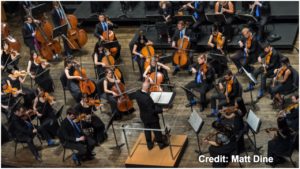
The Orchestra Now 2018-19 Review: Verdi’s Requiem
Leon Botstein And Company Deliver An Immaculate Presentation of Verdi’s Famed Work
By Matt CostelloThe Verdi “Requiem” is an interesting work in the canon of both Verdi and choral music, for a number of reasons.
It would certainly seem an unusual piece for the notoriously non-religious Verdi, who might even seem anti-clerical. Add to that the fact that the “requiem” — a hit, if you will, performed globally by Verdi, from Milan to Paris to London – seems, considering its the premiere year of 1873, to be an almost defiant, jubilant response to the rampant Wagnerism of the day.
And while Verdi did already have the ‘Libera me,” previously composed for the Rossini requiem — a project with other composers that failed to materialize — this solo requiem for the great Italian writer Alessandro Manzoni, was both out of character and yet showed the maestro at the very peak of his powers.
“Only a genius could write such a work,” Johannes Brahms once stated.
Best Concert Space For Masterpiece
First, this performance took place on a – finally! — wonderfully warm spring afternoon in Annandale-on-Hudson, home to the Richard B. Fisher Center for the Performing Arts at Bard College.
With The Orchestra Now, under its conductor (and Bard president) Leon Botstein, Verdi’s masterpiece was to be enjoyed in what is – to my mind – one of the acoustic treasures of the Northeast. With rich sound and fantastic sightlines, the stunning Frank Gehry-designed concert hall is nothing short of world-class.
One would need search for a better concert performance space than the center’s Sosnoff Theater. Carnegie Hall perhaps, for its sound to be sure. But for the experiencing the performance, the intimacy of this theater is special indeed.
And with the graduate student orchestra supplemented with members of the Bard College Conservatory Orchestra, the Bard Festival Chorale, and Bard College Chamber Signers, how did what Hans Von Bulow sneeringly call “Verdi’s latest opera in ecclesiastical garb” fare?
Bringing Out The Details
Having heard the work a number of times (as well as having so many recordings in my head), this clearly was one of the most memorable and moving Verdi “Requiems” I have heard.
Conductor Botstein consistently demonstrated an ability to bring the massive forces together, with a precision that had the array of forces cohere with great, controlled power. And, as usual for Botstein, he brought out details and shadings in the work that, well, seemed entirely new.
And with a graduate student orchestra, that youth and exuberance meant that – with all that detail and attention in place – the performance was, at many times, earthshakingly exciting. The “Tuba Mirum,” with trumpets placed in the upper balcony, produced a tidal wave of sound, and yet always remained musical, always controlled, as if that hurricane rattling outside your front door could be controlled.
As to “Requiem’s” quieter moments, the shading that Botstein elicited from the orchestra, the chorus and the soloists — in sections like the “Liber scriptus” or the “Ingemisco” — brought both a clear beauty of sound and a solemn peace amidst the Requiem’s stormy moments, always with fierce “judgement,” of course pending.
Standout Moments
All of the soloists had stand-out moments, and the quartet performed as unified group, sensitive to the interplay of the classic four voices.
One could sense a keen awareness and attention to each other’s singing. The sections where mezzo-soprano Chloe Schaaf and Soprano Margaret Tigue sang together — such as the “Recordare” — were sublime. At such moments, the pair sang seamlessly together, creating a special beauty of tone, expression and even meaning for the mass’s text.
The tenor, Cooper Nolan, also both brought a clear, ringing voice to ensemble moments, such as the plaintive “Quid sum miser” and then made his solo of the “Ingemisco” fill the hall with his great tenor voice.
The bass occupies a special place in all Verdi’s works, as if that voice represents peace and reconciliation – a grounding amidst the drama. Wei Wu’s bass did exactly that, and with a volume and depth that was wonderfully rich and warm, while also able to powerfully carry over the orchestra at climactic moments.
It is in the latter art of the “Requiem” that I’ve always felt that Verdi, for lack of a better word, wanted to go out with a bang and, at the same time, a whisper.
The Pause
After the dizzying, near giddy “Sanctus” from the chorus, there is a pause. As if we take a deep breath before the three very special final sections are performed. Again, we were treated to the interplay of Soprano Tigue and Mezzo Schaaf. Then the quartet soared, once more musically in sync, for a brilliant “Lux aeterna,” which especially showcased Schaaf’s mezzo.
Until it was time for the final section. The original piece Verdi composed for the abandoned Rossini requiem.
“Libera me.”
Now, I am probably not the only person in the theater who – for before that finale – heard in one’s memory the fierce, fantastic singing of Leontyne Price.
And yet Tigue — unknown to me, career beginning — not only produced ringing, bell-like tones that navigated the substantial demands of the section. The music was delivered by her with a power and a seeming effortlessness that was quite amazing. The sheer beauty of the voice something so very special.
Then after that, the quiet ending. A moving hush, as in that moment perhaps where people throw a handful of sand on a grave, the solemn ceremonies over.
And when the audience – and I do not exaggerate here — shot to their feet as one, we perhaps all well knew there might not have been a better place to hear this great music, performed at this level of excellence, on this day just about anywhere.


